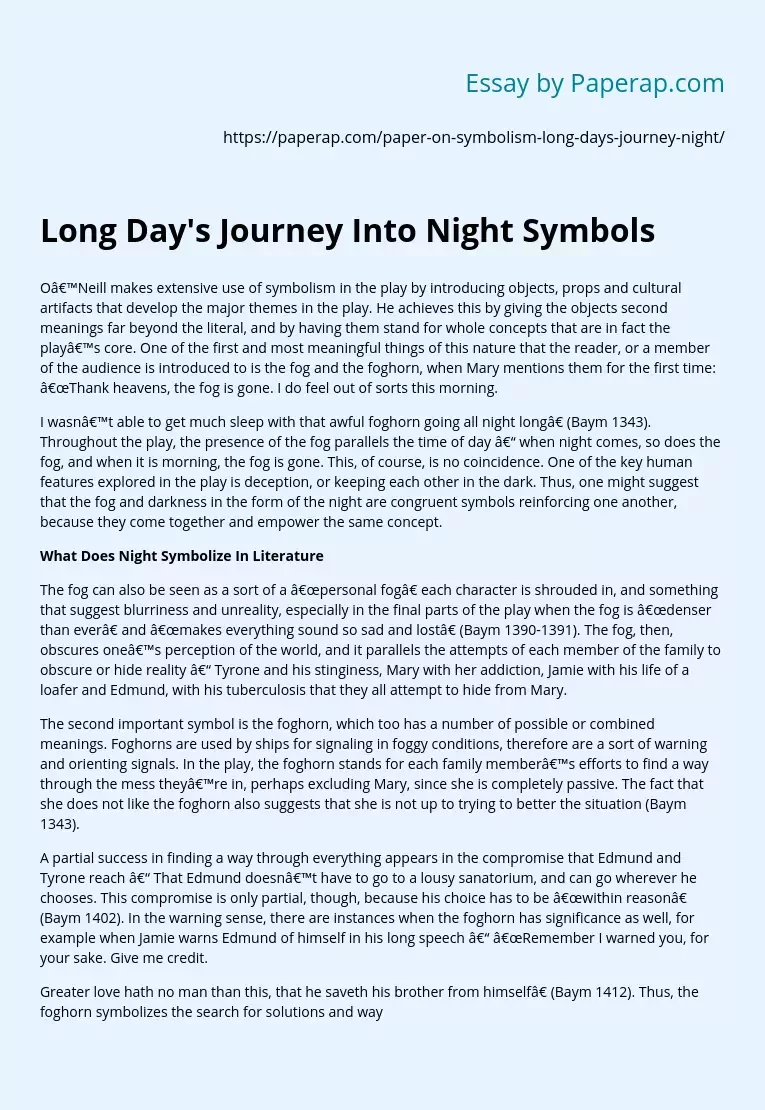Long Day's Journey Into Night Symbols
O’Neill makes extensive use of symbolism in the play by introducing objects, props and cultural artifacts that develop the major themes in the play. He achieves this by giving the objects second meanings far beyond the literal, and by having them stand for whole concepts that are in fact the play’s core. One of the first and most meaningful things of this nature that the reader, or a member of the audience is introduced to is the fog and the foghorn, when Mary mentions them for the first time: “Thank heavens, the fog is gone.
I do feel out of sorts this morning.
I wasn’t able to get much sleep with that awful foghorn going all night long” (Baym 1343). Throughout the play, the presence of the fog parallels the time of day – when night comes, so does the fog, and when it is morning, the fog is gone. This, of course, is no coincidence. One of the key human features explored in the play is deception, or keeping each other in the dark.
Thus, one might suggest that the fog and darkness in the form of the night are congruent symbols reinforcing one another, because they come together and empower the same concept.
What Does Night Symbolize In Literature
The fog can also be seen as a sort of a “personal fog” each character is shrouded in, and something that suggest blurriness and unreality, especially in the final parts of the play when the fog is “denser than ever” and “makes everything sound so sad and lost” (Baym 1390-1391).
The fog, then, obscures one’s perception of the world, and it parallels the attempts of each member of the family to obscure or hide reality – Tyrone and his stinginess, Mary with her addiction, Jamie with his life of a loafer and Edmund, with his tuberculosis that they all attempt to hide from Mary.
The second important symbol is the foghorn, which too has a number of possible or combined meanings. Foghorns are used by ships for signaling in foggy conditions, therefore are a sort of warning and orienting signals. In the play, the foghorn stands for each family member’s efforts to find a way through the mess they’re in, perhaps excluding Mary, since she is completely passive. The fact that she does not like the foghorn also suggests that she is not up to trying to better the situation (Baym 1343).
A partial success in finding a way through everything appears in the compromise that Edmund and Tyrone reach – That Edmund doesn’t have to go to a lousy sanatorium, and can go wherever he chooses. This compromise is only partial, though, because his choice has to be “within reason” (Baym 1402). In the warning sense, there are instances when the foghorn has significance as well, for example when Jamie warns Edmund of himself in his long speech – “Remember I warned you, for your sake. Give me credit.
Greater love hath no man than this, that he saveth his brother from himself” (Baym 1412). Thus, the foghorn symbolizes the search for solutions and ways around obstacles, but just as an actual foghorn on a ship, this search does not actively bring solutions about – for the most part, it only emphasizes the presence of difficulties (the fog). A third major object, or objects, that stand for an important concept in the play are alcohol and morphine. The reason I chose to group them together is because both stand for the same concept – escape.
Alcohol does it for the men in the family, and morphine is Mary’s scene, but they all seek to escape what plagues them and these substances alter their thinking and perception (at least in theory) to do that. Nearly every stressful conversation or encounter that brings up any of the family’s troubles results in either one (or more) of the men drinking, or Mary going upstairs to take morphine – “I understand that I’ve been a God-damned fool to believe in you! Tyrone says as he realizes that his wife is back on the drug, and immediately pours himself a big drink (Baym 1366). Edmund drinks on several occasions although he isn’t supposed to due to his illness, and even though his father knows it, he still lets him drink with only symbolic protest, probably because he subconsciously realizes that Edmund needs the escape just like him (Baym 1393). This peaks in the final scenes of the play, when the whole family is under the influence, and in a state of stupor.
In the effort to obscure the grim reality from their minds (all of this with the dense fog outside and the “faint haziness in the air”), the men are all drunk, and Mary is higher than ever on morphine, according to Tyrone (Baym 1416). Therefore, both alcohol and morphine stand for the family’s collective effort of escape. From the examination of the above and other objects, props, or cultural artifacts in the play, it becomes evident that the vast majority of those used by O’Neill were meant to stand for more complicated concepts, and to act as symbols that develop the major and underlying themes of the play.
Long Day's Journey Into Night Symbols. (2019, Dec 05). Retrieved from https://paperap.com/paper-on-symbolism-long-days-journey-night/

